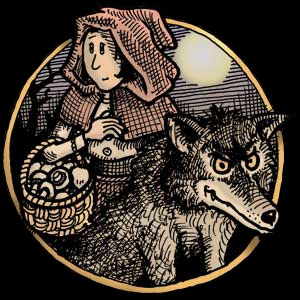Around ten years ago, maybe a little less, I went into a school to talk to the children about fairy tales, to read them Neil Gaiman’s Wolves in the Walls, and to test out their reaction to the folk-talesy (very) short stories that I had written to preface each of the Knot-Shop Man books.
Actually the children were aged around 8, which is younger than the Knot-Shop Man audience I was writing for*. And if you’ve read any of those five stories (oddly I can’t remember if we did The Girl & the Wolf, which from what follows seems likely) you’ll know they are a bit askew, and not happy: more folktale faerie than Disney fairy, certainly.

The Girl & the Wolf
from The Knot-Shop Man project.
The astonishing thing to me, knowing these little people were much too young to be cynical, or alert to metaphor or aphorism or whatever it is I might think is really going on in those stories, was that they liked them. In fact, they were hushed throughout each reading and some of them loved them, when we talked about them afterwards. The Poet & the Princess, which is a literally (yes) disheartening story, was the one they liked the most, and it was at that point I remember thinking, wow, there’s something going on here because I had not thought an 8-year-old would like something quite this bleak, this finger-wagging, this unworldly.**
Anyway, as part of that morning, we talked about wolves, and I invited the children to describe wolves and their characteristics. As expected, what I got back was the thumpingly bad press our fairytales have given wolves, even though — by their own admission — only one or two children in the room could claim to have ever encountered one, and that of course was in a zoo (television, we all agreed, did not count). But when I asked, “who here is afraid of wolves?” maybe only the most timid six of the twenty-four children put their hands up.
At which point I paraphrased Angela Carter’s The Company of Wolves and re-framed the question: “Well, what if I told you there were two kinds of wolves? There are wolves that are hairy on the outside, and when they eat you go to heaven. But then” — and here of course I got louder, and a bit taller — “there are the wolves that are hairy on the inside, and when they clamp their jaws on you they drag you down with them to Hell! NOW WHO’S SCARED OF WOLVES?” Every single child in the room shot their hand into the air, and thus I had primed them for a wide-eyed, breath-holding, lip-biting sitting of The Wolves in the Walls.
It’s one of my favourite children’s books for a number of reasons, mainly (of course) the excellent reversal it contains (read it; I won’t spoil it). But also the presentation withstands detailed scrutiny: for the observant, Dave McKean’s illustrations are strictly disciplined, with the world, the people, and the wolves each rendered with a different technique. So there’s a lot to investigate with a classroom of interested youngsters — not just the story, but the way those two collaborators (Gaiman and McKean) have chosen to present it.
The other thing I did in that session — separate from the wolves — was to look at the “pattern of three” in fairytales. Of course the children can easily provide examples once you’ve asked them to think about it: why not the four little pigs? Who ever thinks about only making two wishes? And so on (naturally, Lucy in Wolves in the Walls warns the members of her family three times). One of my favourite examples of this threesiness is from Jim Henson’s The Storyteller, which includes the line, “She cried and she cried and she cried until she cried a hole in her heart.” It’s a simple sentence that young children can easily understand, but they can also recognise that nobody normally talks like this — it’s a pattern reserved for the poetic world of storytelling.
So as an exercise, I asked the children to write sentences in this form. They wrote them down and read them out, and we had a lot of fun. “He laughed and laughed and laughed until his head fell off!” (the whole class laughs for that one). “She ran and ran and ran until she got home” (OK, that works). And lots more. Then, in the corner, the teacher whose class I had commandeered put her hand on a little boy’s shoulder and said, “Henry has written one.” I remember he had used a pencil, where his more confident classmates had been using pens. He quietly read out:
“He lived and lived and lived until he died.”
Henry, I hope you’re out there somewhere now, writing, because when you were eight you were already hitting the target.
* For common-sense anti-child-patronising reasons, I’m wary of “reading ages”, but nominally The Knot-Shop Man was written for children a few years older than that.
** Which is of course yet another reason to oppose putting age suitability on books, although that’s not my point here.

